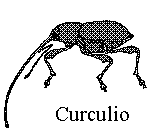Michael Hendry
Last updated: 23 June, 2001

|
Michael Hendry Last updated: 23 June, 2001 |
 |
Until recently, the works of the Latin poet Claudian (Claudius Claudianus, floruit 395-404) were not available on CD-ROM or, with a few exceptions, on the Web. B. G. Teubner has published a CD-ROM advertised as containing Hall's Claudian, but it is very expensive and I have not seen it. There are now three sites besides this one that provide multiple works of Claudian: William L. Carey's Latin Library, David Camden's Forum Romanum, and Angelo Luceri's Claudianus Homepage. None yet contains the complete works. The latter two include some links to my texts, and Luceri also links to the other two. All three are very much under construction, as is mine.
Though no expert on the works of Claudian, I have endeavored to fill the (now rapidly closing) gap by composing my own texts, with brief marginal notes. These do not aim at a full apparatus criticus but include all deviations from J. B. Hall's Teubner text (Leipzig, 1985), places where I am torn between two plausible readings, and the occasional conjecture of my own, the last usually, though not always, confined to the margin.
For the manuscripts, I use the following shorthand: 'O' (for omnes) means all of the primary manuscripts for a particular poem (Hall's 'omnes mei'): these differ from poem to poem. 'C' (for codex) means one or more of Hall's primary manuscripts: a reading that has a fair chance of being ancient. 'c' means one or more of the non-primary manuscripts. This means of course that more than one variant may be labeled 'C', and more than one may be labeled 'c'. Finally, 'I' refers to readings found in the Isengrin edition (Basel, 1534), which seem to come from a manuscript better than any that survives.
For details on specific manuscripts, consult Hall's indispensible edition and the companion volume, Prolegomena to Claudian (BICS Supplement 45, London, 1986). His separate edition of De Raptu Proserpinae (Cambridge Classical Texts and Commentaries 11, 1969) is also essential reading for those interested in the text of Claudian. Professor Joachim Gruber of Munich has a very useful Bibliography of Claudian on his web page.
In the index files, the font and style used for each title gives some information as to its genre. The Carmina Maiora and the other works on the same scale — the Panegyric for Olybrius and Probinus and De Raptu Proserpinae — have titles in bold to show that they are major works, the more substantial Carmina Minora are in Roman font (neither bold nor italic), the titles of the epigrams are in italics, and the fragments referred to by their first line have their titles in quotation marks. Thus In Rufinum I is a full-scale work that fills an entire book roll (one of the Carmina Maiora), while Laus Serenae is one of the Carmina Minora, De Apro et Leone an epigram, and 'Rimanti telum ira facit' a fragment.
§